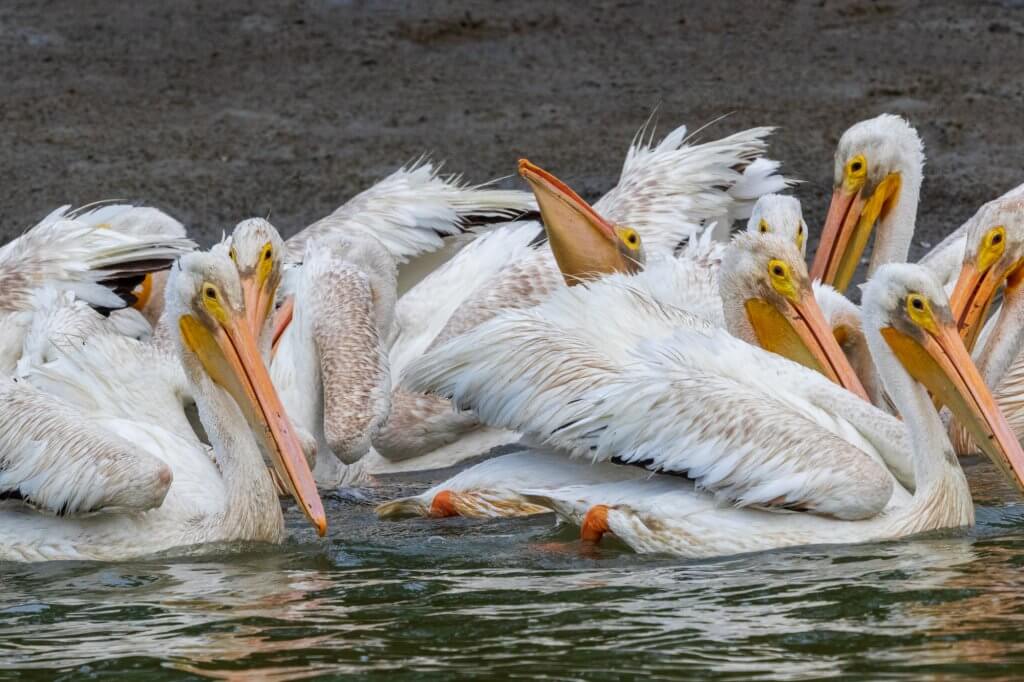White pelicans on the rise
One of the largest birds in North America, this spectacular animal now hangs out at China Camp in increasing numbers.
If you live in the Bay Area, you’re probably well acquainted with the high-diving antics of the California brown pelican (Pelecanus occidentalis californicus). But now there seems to be a new kid—or bird—in town. Increasing numbers of American white pelicans (Pelecanus erythrorhynchos) have been showing up in the region, including in the San Pablo Bay waters surrounding China Camp.
These impressive birds are significantly larger than brown pelicans, weighing as much as 20 pounds. (Smaller brown pelicans typically tip the scale at less than 10 pounds.) To support that girth, white pelicans soar on broad, black-and-white wings spanning nine feet or more—second only to the California condor in North America. White pelicans are strong flyers, and can often be spied carving wide circles high in the sky. These pelicans migrate in large groups between the Bay Area and their nesting areas inland in Northern California and Nevada. These breeding sites often consist of thousands of birds. Two eggs per nest is the norm, though only one chick usually survives.

Colonies of breeding birds have been known to move in response to environmental degradation. For example, there was once a large nesting colony at the Salton Sea, south of Palm Springs. But as that large inland lake shrank and become saltier, its resident fish populations, mostly introduced tilapia, died off, forcing white pelicans and other fish-dependent species to find other feeding grounds. That said, no breeding pairs have been spied in the Bay Area to date.
White pelicans have a distinctively different way of feeding compared to their smaller brown cousins. While it’s common to see large numbers of brown pelicans diving from high in the air and splashing headfirst into the water, the white pelican is a dipper. While paddling in the shallows, the bird sweeps its large pouch through the water like a net, capturing small fish, along with a few gallons of water. The bird tilts its head and drains the water, then swallows the fish. Sometimes you will see several white pelicans swimming side-by-side, herding fish to shallower water with their big webbed feet, then sweeping their pouches through the water in synchrony. If you see this, look closely: You may see the skinny black neck and head of a cormorant popping up in the midst of the group of pelicans. It’s not a case of mistaken identity for the cormorant—it’s savvy fishing, as the much smaller black bird dives down to opportunistically pick off any fish that escape from the pelicans’ pouches.
One of the best times to see white pelicans at China Camp State Park is at low tide; get a good view from one of our scenic bayside points. Scan the mudflats where they meet the receding bay waters; the pelicans often cruise this shallow strip in search of fish. Other prime locations in Marin County are the Las Gallinas ponds (adjacent to the sewage treatment plant near McInnis Golf Course). The birds also often fish in the restored wetland just north of The Village shopping complex in Corte Madera, and in the ponds behind the Vintage Oaks shopping center in Novato. While a few pelicans may stick around through winter, most head south to warmer climes, returning to our area in summer.—by Andy Kives, FOCC Volunteer
———
For more on American white pelicans, visit these sources:

